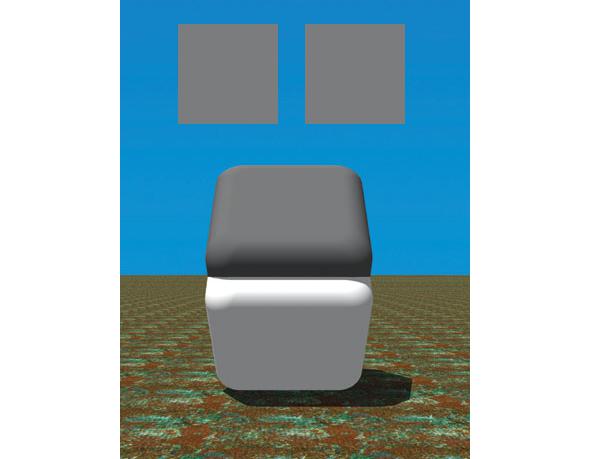Have you seen the latest optical illusion that’s been going around the Web? You simply won’t believe your eyes.
Nor should you.
Here it is:

Illustration by Dale Purves, used by permission
What’s the illusion, you ask? Those two vertical lozenge-shapes are the same shade!
Don’t believe me? Good! It’s always best to check things like this out for yourself. One way is to put your finger across the middle, blocking the part where they meet. When you do that, boom! You can see they’re the same shade of gray.
Here it is graphically:

Illustration by Dale Purves. Modified by Slate.
Amazing, isn’t it? This is called the Cornsweet Illusion, after experimental psychologist Tom Cornsweet. Basically, it works by contrast: When we look at something, we perceive its color and shading relative to other things in the area and how we perceive it’s lit. In the picture here, we perceive the scene as three-dimensional, with the light source to the upper left (note the shadow on the ground). The upper lozenge is shaded so that we see it as tilted away from us at its top (making the bottom look shaded), and the bottom one tilted the opposite way, so its top is lit.
That means our brain sees the upper lozenge as lit, while the bottom one is shadowed. That, coupled with the contrasting shading in between them, messes with how our brains interpret the image, and we think the upper one is darker than the bottom one.
But it isn’t. I actually went into Photoshop and selected the color of the top lozenge and created a square using it, then did the same for the bottom:

Illustration by Dale Purves. Modified by Phil Plait.
As you can see, both squares look the same … because they are. For the graphics geeks: They both have RGB values of (123, 124, 126).
This sort of illusion has been around a long time; the most famous version is probably the checkerboard illusion:

Photo by brusspup, from the video below.
There’s even a video demonstrating it, which I love.
I have a full explanation of the checkerboard on the blog, but it’s the same sort of thing as the one above. Your brain gets bamboozled by the shadow cast by the cylinder, so it thinks the square in the shadow is lighter than the darker squares around it, but in fact it’s the same color and shade.
I love stuff like this! First, because it’s simply delightful. I think people enjoy seeing things that baffle them; puzzles are very enticing and addictive. But there’s another reason I’m so fond of illusions: They show us in no uncertain terms that what we see is not what we get. It’s extremely easy to fool our eyes and brain, and we should never simply trust that what we see, what we think is going on, is a fair and accurate representation of reality.
This is why we have science. Richard Feynman called it (with characteristic simplistic brilliance) “a way of not fooling ourselves”.
I agree. And it’s something to keep in mind when someone claims they saw a UFO, or a ghost, or Bigfoot. Eyewitness reports are notoriously unreliable, even when someone swears up and down “I know what I saw.”
They didn’t. Just like the illusion above, seeing something is just the beginning of the investigation, not the end.
Here are more posts I’ve written about illusions that will baffle and delight and madden you:
The Blue and the Green (my favorite of all time)
This Illusion Will Drive You Mad
Hidden Circles Illusion
Square Circle Spiral
You Spin Me Right Round (and here’s a direct link to the original illusion)
Tip o’ the Necker Cube to David Smith.